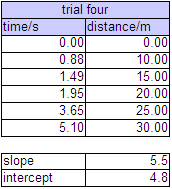

Science is built on experimentation. Science is a field in which a theory is not considered tested until experiments have been unable to prove the theory false. In lecture I present theories and we work homework problems. But the only thing you know for sure based on experimentation is that there is a relationship between distance and time for a ball rolling. And the 8:00 lab section should still have doubts about the nature of the relationship due to some of the data they collected.
The 8:00 science team reinvented the laboratory, allowing a subsequent team of scientists working at 11:00 to collect more data more efficiently. The following data comes from the 11:00 section:


Use the above to answer the following questions:
1. ___________________ Given a time of 0.88 seconds, and a distance of 10.00 meters, calculate the average speed of the ball using the formula d = vt. Remember to include your units and keep only significant digits!
2. ___________________ Given a time of 5.10 seconds, and a distance of 30.00 meters, calculate the average speed of the ball.
3. ___________________ Did the ball speed up or slow down during trial four above?
4. ___________________ What are the correct units for the slope?
5. ___________________ What are the correct units for the intercept?
6. ___________________ What is the physical meaning of the slope – what does it mean?
7. ___________________ Given that distance/m = slope × time/s + intercept, predict the distance the ball would roll after ten seconds. [ Ten seconds after being thrown.]
8. ___________________ Toughie: Given that distance/m = slope × time/s + intercept, predict the time for the ball above to travel 50 meters.
9. __________ Will the ball obey your predictions above?
10. Why, or why not, will the ball above obey your prediction? Use the back if you need more space.